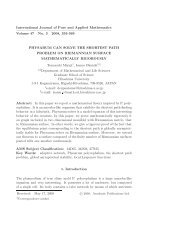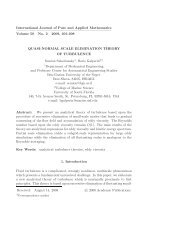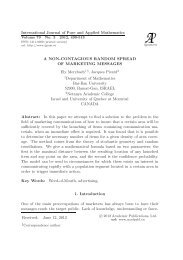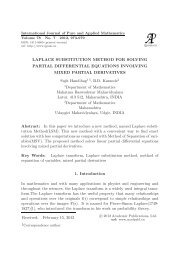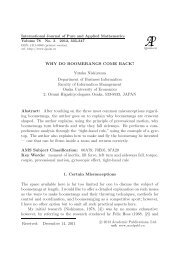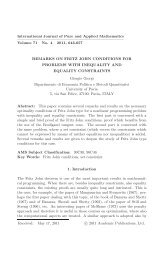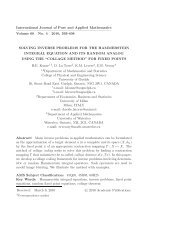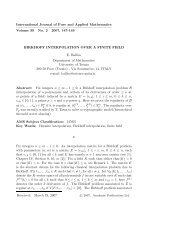FINDING N-TH ROOTS IN NILPOTENT GROUPS AND ...
FINDING N-TH ROOTS IN NILPOTENT GROUPS AND ...
FINDING N-TH ROOTS IN NILPOTENT GROUPS AND ...
You also want an ePaper? Increase the reach of your titles
YUMPU automatically turns print PDFs into web optimized ePapers that Google loves.
582 S. Sze, D. Kahrobaei, R. Dambreville, M. Dupas<br />
Proof. The identity element 1 must be the product of two elements of X.<br />
Since inverse pairs always commute and distinct elements of X do not commute,<br />
we must have x 2 = 1 for some x ∈ X. Now, x = 1 because 1 ∈ Z(G). Hence, x<br />
must have order 2, so |G| has even order. It follows that |G| is a multiple of 4<br />
since it is a perfect square.<br />
Lemma 5.3. If G has a perfect square root, then |Z(G)| 2 < |G|.<br />
Proof. Let X be a perfect square root of G. Since the elements of X do<br />
not commute, no two elements of X are in the same coset of Z = Z(G): for<br />
if z1, z2 ∈ Z, then (az1)(az2) = (az2)(az1). Let |G| = n 2 so that there are at<br />
least n cosets of Z from which to choose as elements of X. That is, we have<br />
[G : Z] = |G|<br />
|Z| ≥ n, or n ≥ |Z|. Now we can conclude that |Z|2 < |G| since X<br />
contains no elements of Z.<br />
Lemma 5.4. Let G be a finite group with perfect square root X. Then<br />
for each z ∈ Z(G), there is some x ∈ X such that x 2 = z.<br />
Proof. Each z ∈ Z(G) is the product of two elements of X, say x1 and<br />
x2. Since z ∈ Z(G) and the pairs x1x2 and x2x1 are conjugate, we must have<br />
x1x2 = x2x1. This contradicts the fact that elements of X do not commute.<br />
Hence, x1 = x2 and z = x 2 1 .<br />
Definition 5.5. Let G be nilpotent of class 2. That is, G satisfies<br />
[[G,G],G] = {1}. We define Q(G) = {q ∈ G|q 2 ∈ Z(G)}.<br />
q 2 1<br />
2.<br />
We have the following results:<br />
Lemma 5.6. Q = Q(G) is a normal subgroup of G.<br />
Proof. We first show that Q is a subgroup of G: let q1, q2 ∈ Q. Then<br />
(q1q −1<br />
2 )2 = q1q −1<br />
2<br />
= q 2 1q −1<br />
2<br />
q1q −1<br />
2<br />
(q2q −1<br />
−1 −1<br />
= q1(q1q2 q2q1 )q−1 2<br />
1 q−1 2<br />
−1<br />
q1)q2 = q2 1q −2<br />
2 [q−1<br />
q1q −1<br />
2<br />
2 ,q1] ∈ Z(G).<br />
Next, to see that Q is normal in G, let g ∈ G. Then (g −1 q1g) 2 = g −1 q 2 1<br />
∈ Z(G).<br />
Lemma 5.7. Let q ∈ Q(G). Then every commutator [q,g] has order 1 or<br />
Proof. [q,g] 2 = [q 2 ,g] = 1.<br />
g =



